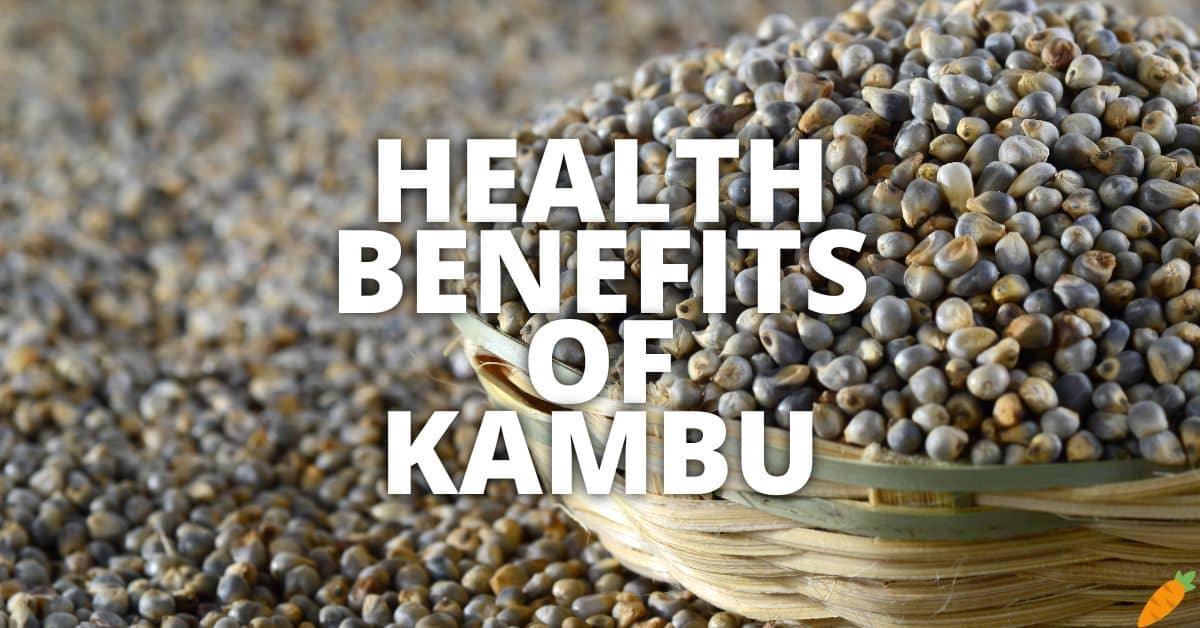It’s an exciting day to analyze the potential health benefits of kambu.
🤔 What is kambu?
Kambu is the Tamil name for “pearl millet.”
It’s a cereal grain primarily grown in arid and semi-arid regions of the world, especially in Africa and India.
Kambu is a staple food in many cultures due to its resilience to harsh weather conditions and its high nutritional value.
It’s rich in essential nutrients like protein, fiber, and minerals.
In culinary applications, kambu can be ground into flour and used in a variety of dishes like porridge, bread, and pancakes.
📝 Here’s a list of the potential health benefits of kambu:
- Nutrient-Dense
- Free Of Gluten
- Packed With Fiber
- Stable Blood Sugar Support
- Cardiovascular Benefits
- Supports Weight Control
- Rich In Antioxidants
- Benefits Bone Strength
- Reduces Inflammation
- Encourages Milk Production
- Helps In Body Cleansing
Please keep reading if you want to learn more.
1. Rich In Nutrients
Kambu is a nutrient-dense grain.
It is packed with protein, which is essential for building and repairing tissues.
The magnesium in kambu aids important functions, including those of nerves and muscles.
Its phosphorus content contributes to the strength of bones and teeth.
Moreover, the B-vitamins in kambu play a crucial role in energy production and supporting metabolism.
Including kambu in one’s diet can help ensure the intake of these valuable nutrients.
2. Gluten-Free
Kambu is a gluten-free grain, making it an excellent alternative for people who can’t consume wheat and related grains.
Gluten is a protein found in many grains, and some individuals are sensitive to or allergic to it.
Those with celiac disease have a severe reaction to gluten and must avoid it entirely.
For these individuals, kambu offers a safe and nutritious option for their meals.
In addition to its gluten-free nature, kambu also provides a range of other health benefits, making it a valuable addition to many diets.
3. High Fiber Content
Kambu boasts a significant amount of dietary fiber.
This fiber helps the digestive system by facilitating smoother bowel movements, which can alleviate constipation.
Additionally, fiber-rich foods like kambu can help prevent overeating by making one feel full more quickly and for longer periods.
Regular consumption of kambu can contribute to a healthier gut.
Moreover, maintaining a diet high in fiber can also support overall well-being and aid in weight management.
4. Low Glycemic Index
Kambu is a grain with a low glycemic index (GI).
Foods with a low GI release sugar slowly into the bloodstream, leading to a gradual and sustained energy release.
This slow sugar release helps prevent sudden spikes in blood sugar levels.
For diabetics, managing these levels is crucial, and incorporating foods like kambu can assist in this.
Consuming kambu can therefore be a strategic choice for those looking to maintain stable blood sugar levels.
5. Heart Health
Kambu is beneficial for heart health due to its magnesium and potassium content.
Magnesium plays a role in the proper functioning of the heart, while potassium helps regulate blood pressure by balancing sodium levels in the body.
Elevated blood pressure is a risk factor for heart disease, so maintaining it within a healthy range is crucial.
Moreover, there’s evidence to suggest that kambu can help reduce LDL cholesterol, often termed “bad” cholesterol.
Keeping LDL levels in check is essential, as high levels can lead to arterial blockages, further emphasizing kambu’s importance for heart health.
6. Weight Management
Kambu is an excellent choice for those focusing on weight management.
Its high fiber content ensures that you feel full quicker and for longer durations, reducing the chances of unnecessary snacking.
When you feel satisfied after a meal, you’re less likely to consume excess calories.
Additionally, fiber aids in digestion and supports a healthy metabolism, further promoting weight control.
Incorporating kambu into meals can therefore be a strategic approach for those looking to manage or reduce their weight.
7. Antioxidant Properties
Kambu is rich in antioxidants, substances that combat oxidative stress in our bodies.
Free radicals, unstable molecules that can harm cells, are the root cause of oxidative stress.
By neutralizing these free radicals, the antioxidants in kambu protect our cells and tissues from harm.
This protection is essential, as prolonged oxidative stress can lead to various health issues, including aging and chronic diseases.
Thus, including kambu in one’s diet not only offers nutritional benefits but also contributes to overall cellular health and well-being.
8. Good For Bone Health
Kambu is a beneficial grain for strengthening bones due to its calcium and phosphorus content.
Calcium is a primary component of bones and teeth, and it plays a crucial role in bone formation and maintenance.
Phosphorus, on the other hand, works hand in hand with calcium to ensure proper bone mineralization.
Consuming foods rich in these minerals, like kambu, supports optimal bone density, reducing the risk of fractures and conditions like osteoporosis.
Hence, incorporating kambu into one’s diet can contribute to robust bone health throughout life.
9. Anti-Inflammatory (My Favorite Potential Health Benefit Of Kambu) ⭐️
Kambu, like other millets, has been recognized for its potential anti-inflammatory properties.
Chronic inflammation can lead to a host of health problems, including joint issues like arthritis.
Consuming kambu can help reduce inflammation in the body, providing relief to those suffering from inflammatory conditions.
Its natural components act to soothe inflamed tissues and reduce pain.
Including kambu in one’s diet can thus be a proactive step towards managing inflammation and supporting overall health.
10. Promotes Lactation
Kambu has long been valued in traditional practices for promoting lactation.
Many cultures believe that consuming kambu can enhance milk production in breastfeeding mothers.
The nutrients in kambu, including essential vitamins and minerals, can support overall health, potentially benefiting lactating women.
While the exact mechanism isn’t fully understood, the belief in kambu’s lactogenic properties persists in many communities.
Mothers looking for natural ways to boost milk supply might consider adding kambu to their diets, though consulting with healthcare professionals is always advised.
11. Aids In Detoxification
Kambu plays a role in aiding the body’s natural detoxification process.
It contains essential amino acids, which support liver function, a key organ in detoxifying the body.
Additionally, the antioxidants in kambu help reduce oxidative stress and neutralize toxins.
By assisting in the removal of harmful substances, kambu can promote better overall health and vitality.
Incorporating kambu into one’s diet can be a beneficial step towards supporting the body’s natural cleansing processes.
💡 Conclusion
Kambu, a traditional grain, is laden with an array of health benefits that cater to various aspects of well-being.
Its nutrient-rich composition offers support for everything from bone health to blood sugar regulation.
With its gluten-free nature, it provides a safe dietary choice for those with gluten sensitivities.
The presence of antioxidants and anti-inflammatory properties further enhances its health-promoting profile.
Incorporating kambu into the diet can be a strategic move for anyone seeking a combination of taste and health benefits from their food.
😊 Among the numerous potential health benefits of kambu, my personal favorite is its possible anti-inflammatory properties.
I suffer from arthritis, and the thought that kambu could alleviate some of the inflammation and associated pain is truly appealing.
By including this grain in my diet, I’m hopeful for some natural relief.
Interestingly, kambu has been cultivated for over 4,000 years, making it one of the world’s oldest known foods.
It’s fascinating that such an ancient grain could offer modern-day benefits for conditions like arthritis!
What’s your favorite potential health benefit of kambu?
😎 I also have articles about other grains and their potential health benefits that you can read here.
If you find this article helpful, please share it with your family and friends.
I appreciate it!
Be healthy 💪 and stay safe 🦺!
⛑️ Safety First
While kambu boasts numerous potential health benefits, it’s essential to approach it with caution.
Some people, especially those with certain grain allergies, should avoid consuming it.
Always discuss with a doctor before making significant dietary changes or relying on kambu for specific health benefits.
It’s worth noting that some of these benefits might be based on anecdotal evidence.
As with any health claim, it’s prudent to do your own research and seek guidance from professionals to ensure safety and efficacy.
📋 Summary
| Potential Health Benefits Of Kambu | Details |
| Rich In Nutrients | Packed with essential vitamins and minerals, such as magnesium, phosphorus, and B-vitamins. |
| Gluten-Free | A natural alternative for those with gluten intolerances, allergies, or celiac disease. |
| High Fiber Content | Its dietary fiber supports digestion, helps reduce constipation, and provides a feeling of fullness. |
| Low Glycemic Index | Being a complex carbohydrate, it promotes stable blood sugar levels, which is beneficial for diabetics. |
| Heart Health | Contains magnesium and potassium, which can help regulate blood pressure and reduce LDL cholesterol. |
| Weight Management | The fiber content assists in controlling appetite, potentially leading to reduced calorie intake. |
| Antioxidant Properties | Enriched with antioxidants that can neutralize harmful free radicals in the body. |
| Good For Bone Health | Offers calcium and phosphorus, which are crucial for bone density and overall bone health. |
| Anti-Inflammatory | Some studies suggest its properties can help reduce inflammation, which is beneficial for conditions like arthritis. |
| Promotes Lactation | Traditionally believed to enhance milk production in breastfeeding mothers. |
| Aids In Detoxification | Contains essential amino acids and antioxidants that assist the body in detoxifying processes. |
⚠️ Content Disclaimer
The content provided here is for informational purposes only and does not constitute professional advice.
While every effort has been made to ensure accuracy, the information may not apply to all situations or individuals.
Readers are encouraged to seek expert advice or conduct their own research before making any decisions based on this content.
The publisher or author holds no responsibility for any actions taken based on the information provided here.
Always consult with a relevant professional to address specific concerns.

